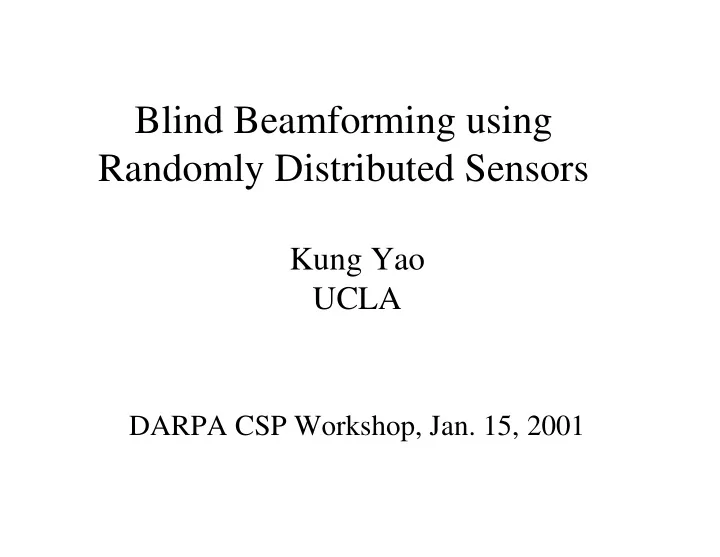

Blind Beamforming using Randomly Distributed Sensors Kung Yao UCLA DARPA CSP Workshop, Jan. 15, 2001
Outline • Introduction to blind beamforming array • Different usages of blind beamforming arrays • Applications 1. Acoustic source localization 2. Acoustic source DOA/prop. speed estimation 3. Seismic source tracking 4. NTC vehicle tracking with known seismic sensor locations 5. NTC vehicle tracking with one unknown seismic sensor location
Beamforming with Randomly Distributed Sensors Sensor Network I Beamforming Base Station Base Station n th Disturbance Wavefront m th Disturbance Wavefront Sensor Network j Sensor Node Beamforming
Beamforming for Arrays of Fixed vs. Randomly Distributed Sensor Geometry •Almost all prior beamformers exploit fixed and known geometry of sensors through the array steering vector information •For randomly dist. sensors, we can only use the measured sensor data; exploit time- difference of arrival information •Proposed blind beamforming algorithm uses sensor data to form a sample data or a sample correlation matrix
•Blind beamforming array weights are obtained from dominant singular/eigen- vector of the above collected matrix either in block or recursive form •Szegö theory of asymptotic distribution of eigenvalues shows this array collects the maximum power from the source modeled as a wideband stationary proc. with thus provides some rejection capability of other interferences and noises
Usefulness of Blind Beamforming Array • Array can do coherent combining to enhance strongest source for: Increased P D and decreased P FA ; Improve source ID/classification • Array can determine angle of arrival and/or location of source relative to some coordinates • Array can estimate speed of propagation • Array can determine locations of unknown sensors given other known sensor locations • Array can track the movement of the source • Passive operations with low cost/processing
Appl. 1- Acoustic Source Localization • ARL measured tracked vehicle acoustic source with a spectral peak at 100 Hz • A simulated second-order AR source at 120 Hz • Three sensors at {(12,0), (0,12), (-9,0)} • Vehicle at (7,-12); AR source at (6.08, -8.438) • Vehicle to sensor time delays {12, 7,5} • AR source to sensor time delays {11, 7, 4} • Compare proposed blind beamforming max. power algorithm to classical correlation method
Appl. 2 - Acoustic DOA/ Prop. Speed • 10 microphones on a circle of 4 feet radius and one microphone in the center
Estimated Relative Time Delays by Blind Beamforming Array
Estimated Direction of Arrival of Vehicle using the Constrained Least- Squares Method
Estimated Propagation Speed using the Constrained LS Method • Constant decrease of propagation speed from 1180 ft/sec to 1130 ft/sec (35 MPH) may be due to the components of vehicle and wind speeds along DOA before/after CPA
Appl. 3 - Seismic Source Tracking Wildwood State Park, CA
• Estimated vehicle trajectory is close to true trajectory at Y = 3 feet
Appl. 4 - NTC Tracked Vehicle Tracking • Measured/smoothed rel. time delays compared to L 1 norm parametric modeled rel. time delays vs. time from 6 seismic sensors
Tracking using Opt. Parametric Model
Estimated Vehicle Trajectory and Road
Appl. 5 - NTC Vehicle Tracking with Unknown Sensor Location
Recommend
More recommend